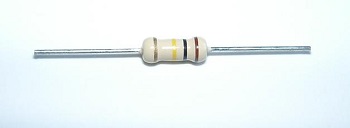Resistor

Resistors are electrical components in an electric circuit that slow down current in the circuit. They deliberately lose energy in the form of heat or thermal energy.
Appliances such as electric heaters, electric ovens, and toasters all use resistors to turn current into heat, then using the heat lost from this resistor to warm the surrounding area. Even the filament from an incandescent light bulb is effectively a resistor, slowing down the current and heating up a wire to a high enough temperature that it gives off light. This light given off is known as blackbody radiation.
Resistors also have applications in electrical devices like computers and cell phones to damp out unwanted electrical signals. It's counter-intuitive, but even though energy is dissipated with resistance, resistors are absolutely essential to the proper functioning of electronics. They function to ensure that other components aren't provided with too much voltage or electric current.
Resistors have a resistance from a few Ohms (Ω) to several Megaohms (MΩ = million Ohms). For more detailed information on resistors please see hyperphysics. An explanation of the colour code seen in figure 1 can be found here.
Types of Resistors

There are numerous different ways to build a resistor, and each method has benefits and drawbacks in terms of versatility and cost. The two major types of resistors that can be seen are variable and fixed resistors.
Variable
Variable resistors, shown in Figure 2, are simply a special type of resistor that can be adjusted to any ohmic value - or level of resistance - within a certain range.
Fixed
These resistors are the most common type of resistor and are built to resist at a specific ohmic value - meaning simply that they have one associated, pre-determined resistance value. There are several types of fixed resistors that exist, the main type being carbon-composition. Some specific types of fixed resistors include:

- Carbon-Composition: This type of resistor, shown in Figure 3, has two metal leads separated by a column of carbon dust or graphite in the middle. As current flows past the first lead it reaches the carbon column, which resists a fraction of the moving charge. Current then passes through to the second lead at a lower current value than it started at initially.[4] The resistivity of the carbon column can be modified by introducing impurities, the effect on resistivty depends on the impurity added.
- Wire Wound: This type of resistor has 2 leads with a coiled wire in between to provide resistance. The greater the length of wire the more resistance that is provided. Wire wound resistors are the most commonly used resistor in high power applications because they have a high surface area in comparison to carbon-composition resistors.[4] This increased surface area allows them to dissipate a larger amount of heat, which is required for such applications.
- Integrated: Integrated resistors are made with semi-conductors other than carbon. They are very small and therefore can have several packed into a single casing, however they are limited to low current applications.
For Further Reading
For further information please see the related pages below:
References
- ↑ HyperPhysics. (December 7, 2014). Resistors [Online]. Available: http://hyperphysics.phy-astr.gsu.edu/hbase/electronic/rescarb.html
- ↑ Wikimedia Commons. (May 20, 2015). PCB Variable Resistors [Online]. Available: http://commons.wikimedia.org/wiki/File:PCB_variable_resistors.jpg#/media/File:PCB_variable_resistors.jpg
- ↑ Wikimedia Commons. (May 20, 2015). Resistor [Online]. Available: http://commons.wikimedia.org/wiki/File:Resistor.JPG#/media/File:Resistor.JPG
- ↑ 4.0 4.1 Electronics Tutorial. (May 20, 2015). Types of Resistors [Online]. Available: http://www.electronics-tutorials.ws/resistor/res_1.html

